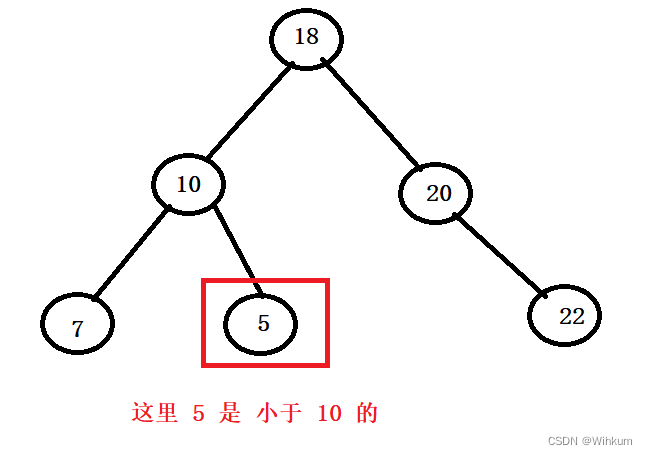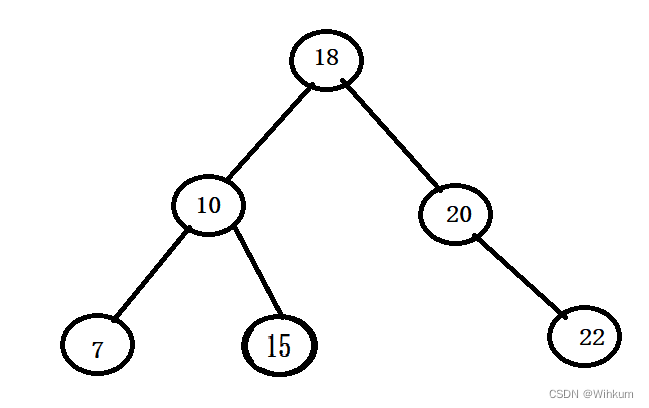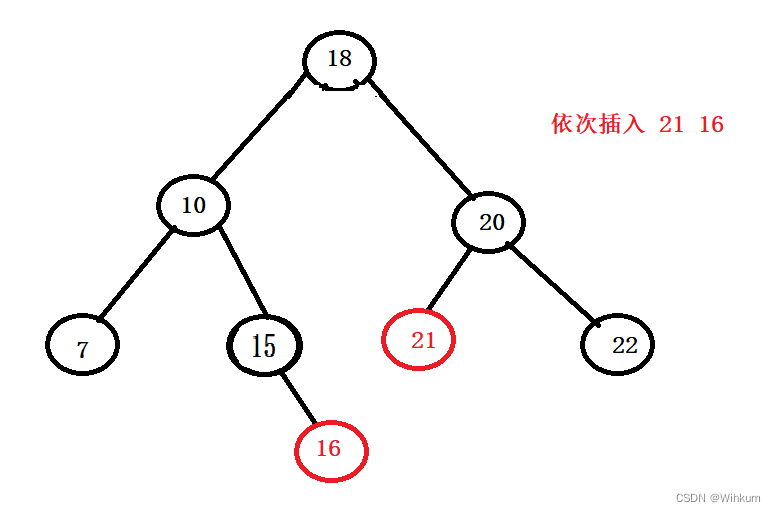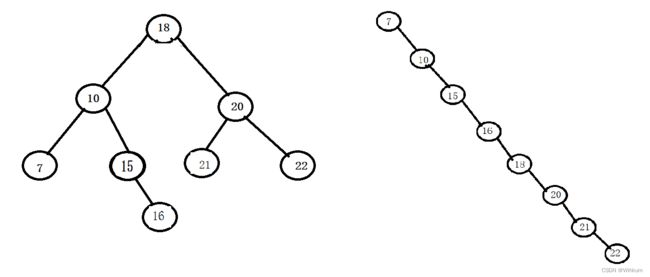二叉搜索树的操作、模拟实现、应用以及性能的介绍
一、二叉搜索树
1. 性质
(1)如果左子树不是空,那么左子树上的所有节点的值都小于根节点的值
(2)如果右子树不是空,那么右子树上的所有节点的值都大于根节点的值
(3)左右子树也分别为二叉搜索树
如下图:
① 下面这个情况不是二叉搜索树
因为 5 作为 10 的右子树,是小于 10 的
② 下面是可行的
二、二叉搜索树的操作
1. 二叉搜索树的查找
(1) 从根开始比较,查找,比根大则往右边走查找,比根小则往左边走查找。
(2) 最多查找高度次,走到到空,还没找到,这个值不存在。
2. 二叉搜索树的插入
(1) 插入的具体过程如下:
① 树为空,则直接新增节点,赋值给 root 指针
② 树不空,按二叉搜索树性质查找插入位置,插入新节点
3. 二叉搜索树的删除
(1) 首先查找元素是否在二叉搜索树中,如果不存在,则返回, 否则要删除的结点可能分下面四种情况:
① 要删除的结点无孩子结点
② 要删除的结点只有左孩子结点
③ 要删除的结点只有右孩子结点
④ 要删除的结点有左、右孩子结点
(2) 看起来有待删除节点有4中情况,实际情况a可以与情况b或者c合并起来,因此真正的删除过程如下:
情况①:删除该结点且使被删除节点的双亲结点指向被删除节点的左孩子结点--直接删除
情况②:删除该结点且使被删除节点的双亲结点指向被删除结点的右孩子结点--直接删除
情况③:在它的右子树中寻找中序下的第一个结点(关键码最小),用它的值填补到被删除节点中,再来处理该结点的删除问题--替换法删除
三、二叉搜索树的实现
#pragma once
#include
using namespace std;
// 二叉搜索数 —— 去重
template
class BinarySearchTreeNode
{
public:
BinarySearchTreeNode* _left;
BinarySearchTreeNode* _right;
K _key;
BinarySearchTreeNode(const K& key)
: _left(nullptr)
, _right(nullptr)
, _key(key)
{}
};
template
class BinarySearchTree
{
typedef BinarySearchTreeNode Node;
public:
// 去重 所以不能有相同的 key 值结点
bool Insert(const K& key)
{
if (_root == nullptr)
{
_root = new Node(key);
return true;
}
// parent 记录 cur 前一个结点 方便链接
Node* parent = nullptr;
Node* cur = _root;
while (cur != nullptr)
{
if (key > cur->_key)
{
parent = cur;
cur = cur->_right;
}
else if (key < cur->_key)
{
parent = cur;
cur = cur->_left;
}
else
{
// 相等 key 值 返回 false 去重
return false;
}
}
Node* newnode = new Node(key);
if (key > parent->_key)
{
parent->_right = newnode;
}
else
{
parent->_left = newnode;
}
return true;
}
bool Find(const K& key)
{
Node* cur = _root;
while (cur != nullptr)
{
if (key > cur->_key)
{
cur = cur->_right;
}
else if (key < cur->_key)
{
cur = cur->_left;
}
else
{
return true;
}
}
return false;
}
bool Erase(const K& key)
{
Node* prev = nullptr;
Node* cur = _root;
while (cur != nullptr)
{
if (key > cur->_key)
{
prev = cur;
cur = cur->_right;
}
else if (key < cur->_key)
{
prev = cur;
cur = cur->_left;
}
else // 找到了
{
if (cur->_left == nullptr)
{
if (cur == _root)
{
_root = cur->_right;
}
if (cur == prev->_right)
{
prev->_right = cur->_right;
}
else
{
prev->_left = cur->_right;
}
delete cur;
cur = nullptr;
}
else if (cur->_right == nullptr)
{
if (cur == _root)
{
_root = cur->_right;
}
if (cur == prev->_right)
{
prev->_right = cur->_left;
}
else
{
prev->_left = cur->_left;
}
delete cur;
cur = nullptr;
}
else // 两边都不为 nullptr
{
// 找左子树的 最大 结点替换要删除的位置
// 或者
// 找右子树的 最小 结点替换要删除的位置
// 最后删除
// 找右子树的 最小 结点替换
Node* prevmin = cur;
Node* min = cur->_right;
// 找完右子树最小结点之后 说明此时结点的右已经为 nullptr 了
while (min->_left)
{
prevmin = min;
min = min->_left;
}
swap(&cur->_key, &min->_key);
// min 是 右节点 的最小结点
// 找 min 的时候 min 的最左结点已经为 nullptr 了
if (min->_right != nullptr)
{
if (min == prevmin->_left)
{
prevmin->_left = min->_right;
}
else
{
prevmin->_right = min->_right;
}
}
delete min;
}
return true;
}
}
return false;
}
void InoOrder()
{
_InOrder(_root);
cout << endl;
}
/
// 递归版本
bool FindR(const K& key)
{
return _FindR(_root, key);
}
bool InsertR(const K& key)
{
return _InsertR(_root, key);
}
bool EraseR()
{
return _EraseR(_root, key);
}
//BinarySearchTree()
//{}
// C++ 用法 强制编译器生成默认的构造
BinarySearchTree() = default;
BinarySearchTree(const BinarySearchTree& T)
{
_root = _Copy(T._root);
}
~BinarySearchTree()
{
_Destory(_root);
}
BinarySearchTree& operator=(const BinarySearchTree& T)
{
swap(_root, T._root);
return *this;
}
private:
void _Destory(Node*& root)
{
if (root == nullptr)
{
return;
}
_Destory(root->_left);
_Destory(root->_right);
delete root->_key;
root = nullptr;
}
Node* _Copy(Node* root)
{
if (root == nullptr)
{
return nullptr;
}
Node* CopyNode = new Node(root->_key);
root->_left = _Copy(root->_left);
root->_left = _Copy(root->_right);
return CopyNode;
}
bool _EraseR(Node*& root, const K& key)
{
if (root == nullptr)
{
return false;
}
if (key > root->_key)
{
return _EarseR(root->_right, key);
}
else if (key < root->_key)
{
return _EarseR(root->_left, key);
}
else // 此时 cur 就是要删的
{
Node* del = root;
if (root->_left == nullptr)
{
root = root->_right;
}
else if(root->_right == nullptr)
{
root = root->_left;
}
else
{
// 两边都不为 nullptr
Node* min = root->_right;
while (min->_left)
{
min = min->_left;
}
swap(min->_key, root->_key);
// 左边肯定是 nullptr 以为找的 右子树 最小值 也就是 右子树最左边的值
return _EraseR(root->_right, key);
}
delete min;
return true;
}
}
// & 是上一个 root->_right 或 root->_left 的 别名
bool _InsertR(Node*& root, const K& key)
{
if (root == nullptr)
{
// 所以这里可以
root = new Ndoe(key);
return true;
}
if (key > root->_key)
{
return _InsertR(root->_right, key);
}
if (key < root->_key)
{
return _InsertR(root->_left, key);
}
else
{
return false;
}
}
bool _FindR(Node* root, const K& key)
{
if (root == nullptr)
{
return false;
}
if (key > root->_key)
{
return _FindR(root->_right, key);
}
else if(key < root->_key)
{
return _FindR(root->_left, key);
}
else
{
return true;
}
}
void _InOrder(Node* root)
{
if (root == nullptr)
{
return;
}
_InOrder(root->_left);
cout << root->_key << " ";
_InOrder(root->_right);
}
private:
Node* _root = nullptr;
}; 四、二叉搜索树的应用
1. K模型:K模型即只有key作为关键码,结构中只需要存储Key即可,关键码即为需要搜索到的值。
比如:给一个单词word,判断该单词是否拼写正确,具体方式如下:
① 以词库中所有单词集合中的每个单词作为key,构建一棵二叉搜索树
② 在二叉搜索树中检索该单词是否存在,存在则拼写正确,不存在则拼写错误。
2. KV模型:每一个关键码key,都有与之对应的值Value,即
① 比如英汉词典就是英文与中文的对应关系,通过英文可以快速找到与其对应的中文,英文单词与其对应的中文
② 再比如统计单词次数,统计成功后,给定单词就可快速找到其出现的次数,单词与其出现次数就是
代码如下:
#pragma once
#include
#include
using namespace std;
// 二叉搜索数 —— 去重
template
class BinarySearchTreeNode
{
public:
BinarySearchTreeNode* _left;
BinarySearchTreeNode* _right;
K _key;
V _value;
BinarySearchTreeNode(const K& key, const V& value)
: _left(nullptr)
, _right(nullptr)
, _key(key)
, _value(value)
{}
};
template
class BinarySearchTree
{
typedef BinarySearchTreeNode Node;
public:
// 去重 所以不能有相同的 key 值结点
bool Insert(const K& key, const V& value)
{
if (_root == nullptr)
{
_root = new Node(key, value);
return true;
}
// parent 记录 cur 前一个结点 方便链接
Node* parent = nullptr;
Node* cur = _root;
while (cur != nullptr)
{
if (key > cur->_key)
{
parent = cur;
cur = cur->_right;
}
else if (key < cur->_key)
{
parent = cur;
cur = cur->_left;
}
else
{
// 相等 key 值 返回 false 去重
return false;
}
}
Node* newnode = new Node(key, value);
if (key > parent->_key)
{
parent->_right = newnode;
}
else
{
parent->_left = newnode;
}
return true;
}
Node* Find(const K& key)
{
Node* cur = _root;
while (cur != nullptr)
{
if (key > cur->_key)
{
cur = cur->_right;
}
else if (key < cur->_key)
{
cur = cur->_left;
}
else
{
return cur;
}
}
return nullptr;
}
void InoOrder()
{
_InOrder(_root);
cout << endl;
}
private:
void _InOrder(Node* root)
{
if (root == nullptr)
{
return;
}
_InOrder(root->_left);
cout << root->_key << " ";
_InOrder(root->_right);
}
private:
Node* _root = nullptr;
};
void Test_BST()
{
BinarySearchTree dict;
dict.Insert("Erase", "删除");
dict.Insert("left", "左边");
dict.Insert("right", "右边");
dict.Insert("double", "双倍");
dict.Insert("Find", "查找");
string str;
while (cin >> str)
{
BinarySearchTreeNode* ret = dict.Find(str);
if (ret)
{
cout << "中文是:" << ret->_value << endl;
}
else
{
cout << "词库没有此单词" << endl;
}
}
} 上面简单改了一下二叉搜索树,改成了 key、value 结构。
五、二叉搜索树的性能分析
(1) 插入和删除操作都必须先查找,查找效率代表了二叉搜索树中各个操作的性能
(2) 对有n个结点的二叉搜索树,若每个元素查找的概率相等,则二叉搜索树平均查找长度是结点在二叉搜索树的深度的函数,即结点越深,则比较次数越多。
(3) 但对于同一个关键码集合,如果各关键码插入的次序不同,可能得到不同结构的二叉搜索树:
最优情况下,二叉搜索树为完全二叉树(或者接近完全二叉树)
最差情况下,二叉搜索树退化为单支树(或者类似单支)



